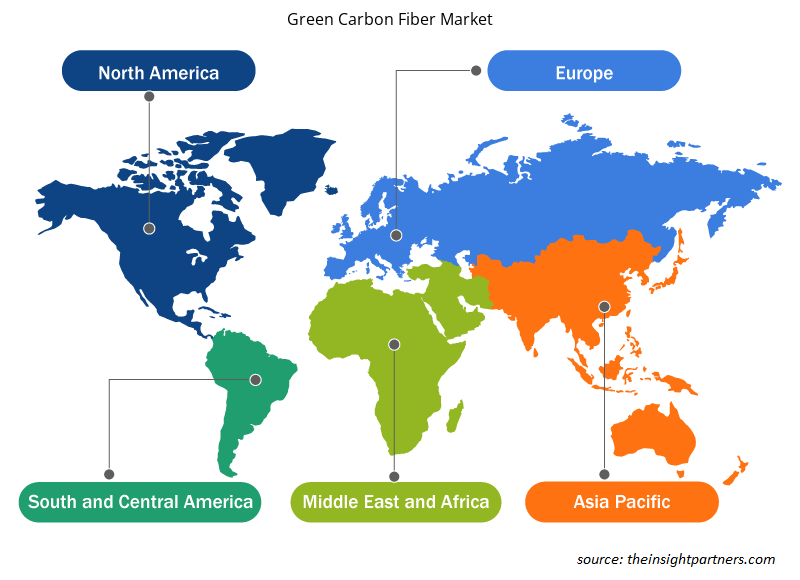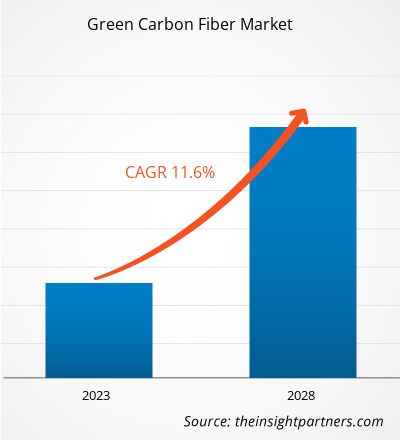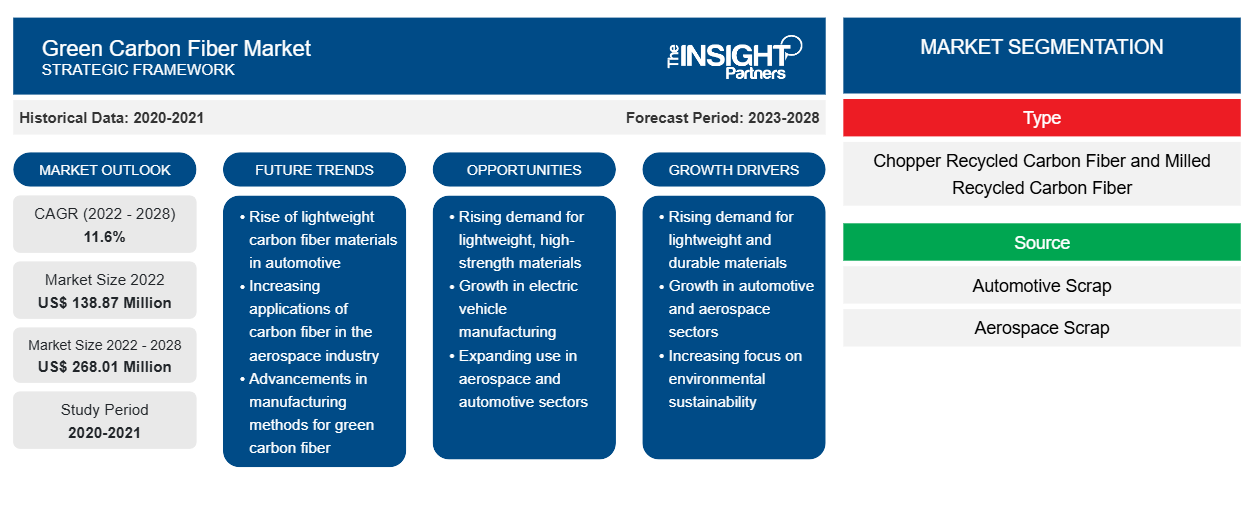[Forschungsbericht] Der Markt für grüne Kohlefasern wurde im Jahr 2022 auf 138,87 Millionen US-Dollar geschätzt und soll bis 2028 268,01 Millionen US-Dollar erreichen; von 2022 bis 2028 wird eine durchschnittliche jährliche Wachstumsrate (CAGR) von 11,6 % erwartet.
Grüne Kohlenstofffasern sind recycelte Kohlenstofffasern. Beim Recycling von Kohlenstofffasern werden Fasern aus kohlenstofffaserverstärkten Verbundwerkstoffen (CFRC) zurückgewonnen. Es gibt zwei Arten von Kohlenstofffaserabfällen. Die erste Abfallart sind Neukohlenstofffasern – Verschnitte des Produkts, das aus trockenen Fasern und dem nicht verwendeten abgelaufenen Material erzeugt wird, das auch als Schrott bezeichnet wird. Grüne oder recycelte Kohlenstofffasern werden zur Herstellung neuer Hochleistungsteile in verschiedenen Endverbrauchssektoren verwendet. Die Vorteile grüner Kohlenstofffasern sowie die steigende Nachfrage nach kostengünstigen, leichten Materialien aus verschiedenen Endverbrauchsbranchen wie Automobil, Luft- und Raumfahrt, Windenergie, Sportartikel usw. kurbeln das Wachstum des Marktes für grüne Kohlenstofffasern an.
Im Jahr 2022 hatte der asiatisch-pazifische Raum den größten Anteil am globalen Markt für grüne Kohlefasern , und Europa wird im Prognosezeitraum voraussichtlich die höchste durchschnittliche jährliche Wachstumsrate verzeichnen. Der asiatisch-pazifische Markt für grüne Kohlefasern ist in China, Japan, Indien, Südkorea, Australien und den Rest des asiatisch-pazifischen Raums unterteilt. Die Luft- und Raumfahrt- und Verteidigungsindustrie im asiatisch-pazifischen Raum ist in den letzten Jahren stark gewachsen. Im asiatisch-pazifischen Raum ist China einer der größten Flugzeughersteller und einer der größten Märkte für inländische Fluggäste.
Passen Sie diesen Bericht Ihren Anforderungen an
Sie erhalten kostenlose Anpassungen an jedem Bericht, einschließlich Teilen dieses Berichts oder einer Analyse auf Länderebene, eines Excel-Datenpakets sowie tolle Angebote und Rabatte für Start-ups und Universitäten.
-
Holen Sie sich die wichtigsten Markttrends aus diesem Bericht.Dieses KOSTENLOSE Beispiel umfasst eine Datenanalyse von Markttrends bis hin zu Schätzungen und Prognosen.
Auswirkungen der COVID-19-Pandemie auf den Markt für grüne Kohlenstofffasern
Länder im asiatisch-pazifischen Raum wie China, Indien und Japan standen während der COVID-19-Pandemie vor großen Herausforderungen aufgrund der Schließung von Produktionsstätten, der Unterbrechung von Lieferketten und der Knappheit an Rohstoffen; dies führte zu einem enormen Einbruch bei der Produktherstellung und -verteilung. Dennoch brachte die Pandemie auch einige lukrative Gelegenheiten für wichtige Akteure auf dem Markt für grüne Kohlefasern im asiatisch-pazifischen Raum. Viele Unternehmen auf dem Markt für grüne Kohlefasern begannen während oder nach der zweiten Welle von COVID-19 mit der Umsetzung staatlicher Protokolle und Normen, um ihre Produkte zu verkaufen, um diese Gelegenheit zu nutzen und den Umsatz zu steigern. Daher neigen staatliche Unterstützungen dazu, die Nachfrage nach nachhaltigen Kohlefasern zu erhöhen und das Wachstum des Marktes für grüne Kohlefasern anzukurbeln.
Markteinblicke
Der zunehmende Einsatz von umweltfreundlichen Kohlenstofffasern in der Windenergiebranche treibt den Markt für umweltfreundliche Kohlenstofffasern an
Die Nachfrage nach Windturbinen steigt rasant, da viele Länder weltweit von klimaschädlichen, nicht erneuerbaren fossilen Brennstoffen auf saubere, erneuerbare Energiequellen umsteigen. Auch die steigenden Strompreise erhöhen den Bedarf an erneuerbaren Energiequellen. Der Windenergiemarkt wächst, da Regierungen verschiedener Länder wie der USA, Deutschlands, Saudi-Arabiens und Chinas Initiativen zur Erzeugung erneuerbarer Energien ergreifen. Eine steigende Nachfrage nach erneuerbaren Energiequellen, insbesondere Windenergie, und Bemühungen, die Abhängigkeit von der Stromerzeugung auf Basis fossiler Brennstoffe zu verringern, sind wichtige Faktoren für das Wachstum des Windenergiesegments und treiben letztendlich das Wachstum des Marktes für grüne Kohlenstofffasern voran.
Mit neuen Kohlenstofffasern (VCF) verstärkte Polymere werden zur Herstellung der Holmgurte von Windturbinenblättern verwendet und Polymere mit Glasfasern werden zur Herstellung der Außenhäute der Rotorblattkomponenten verwendet. Grüne Kohlenstofffasern werden jedoch mittlerweile weithin in Windturbinen verwendet, da Rotorblätter aus recycelten Kohlenstofffasern und Hybridfasern eine um 12–89 % bessere Umweltleistung bieten. Die Energie- und Kohlenstoff-Amortisationszeiten für die Hybridblätter aus recycelten Kohlenstofffasern waren 5–13 % niedriger als bei den etablierten Marktteilnehmern. Die Verwendung von recycelten Kohlenstofffasern für Teile von Windturbinenblättern kann mechanisch machbar sein und bietet im Vergleich zu Glasfasern erhebliche Umweltvorteile. Diese charakteristischen Eigenschaften von Kohlenstofffasern haben zur Herstellung besserer Windturbinenblätter und einer höheren Energieproduktion beigetragen. Daher treibt die zunehmende Verwendung von grünen Kohlenstofffasern in der Windenergiebranche das Marktwachstum voran.
Typbasierte Erkenntnisse
Der Markt für grüne Kohlefasern ist nach Typ in recycelte Kohlefasern aus Hackschnitzeln und gemahlene recycelte Kohlefasern unterteilt. Das Segment der gemahlenen recycelten Kohlefasern hatte 2022 einen größeren Marktanteil. Gemahlene recycelte Kohlefasern werden hergestellt, indem gehackte Fasern zu Pulver (gemahlen) gemahlen werden. Die übliche Länge gemahlener recycelter Kohlefasern beträgt 80–100 Mikrometer. Diese Fasern bieten elektrostatische Ableitung und Festigkeit.
Quellenbasierte Erkenntnisse
Basierend auf der Quelle ist der Markt für grüne Kohlefasern in Autoschrott, Flugzeugschrott und andere unterteilt. Das Segment Autoschrott wird im Prognosezeitraum voraussichtlich die höchste durchschnittliche jährliche Wachstumsrate verzeichnen. Recycelte Kohlefasern können aus etwa 40–60 % des Schrottvolumens bei der Herstellung von kohlenstofffaserverstärktem Kunststoff (CFK) für Kraftfahrzeuge gewonnen werden. Die Verwendung recycelter Kohlefasern kann Automobilherstellern helfen, die Reichweite ihrer Fahrzeuge zu steigern.
Anwendungsbasierte Erkenntnisse
Basierend auf der Anwendung ist der Markt für grüne Kohlefasern in die Bereiche Luft- und Raumfahrt, Automobil, Windenergie, Sportartikel und andere unterteilt. Das Automobilsegment hatte im Jahr 2022 den größten Marktanteil. Die Automobilindustrie verwendet häufig recycelte Kohlefasern zur Herstellung von Fahrgestellteilen, Böden, Dachplatten, Reserveradmulden und Kofferraum- oder Motorhaubeninnenteilen.
Das Unternehmen verwendet ein geschlossenes Verfahren zum Recycling trockener Kohlenstofffasern. Die Produktionskosten von Autos aus recycelten Kohlenstofffasern sind vergleichsweise geringer als die Produktionskosten von Stahl. Außerdem können recycelte Kohlenstofffasern in verschiedene Formen gebracht und gegossen werden, was bei Stahl nicht der Fall ist. Diese Eigenschaften recycelter Kohlenstofffasern stärken ihre Nachfrage im Automobilsektor.
Zu den wichtigsten Akteuren auf dem Markt für grüne Kohlenstofffasern zählen Procotex Corp SA, Vartega Inc, Sigmatex (UK) Ltd, Shocker Composites LLC, Carbon Conversions Co, SGL Carbon SE, Toray Industries Inc, Gen 2 Carbon Ltd, Catack-H Co Ltd und Innovative Recycling. Diese Unternehmen konzentrieren sich auf die Einführung neuer Produkte und die geografische Expansion, um die weltweit wachsende Verbrauchernachfrage zu erfüllen. Sie sind weltweit präsent, sodass sie einen großen Kundenstamm bedienen und so ihren Marktanteil steigern können. Diese Marktteilnehmer konzentrieren sich stark auf die Einführung neuer Produkte und die regionale Expansion, um ihr Produktangebot in Spezialportfolios zu erweitern.
Regionale Einblicke in den Markt für grüne Kohlefasern
Die regionalen Trends und Faktoren, die den Markt für grüne Kohlefasern im Prognosezeitraum beeinflussen, wurden von den Analysten von Insight Partners ausführlich erläutert. In diesem Abschnitt werden auch die Marktsegmente und die Geografie von grünen Kohlefasern in Nordamerika, Europa, im asiatisch-pazifischen Raum, im Nahen Osten und Afrika sowie in Süd- und Mittelamerika erörtert.

- Erhalten Sie regionalspezifische Daten zum Markt für grüne Kohlenstofffasern
Umfang des Marktberichts über grüne Kohlefasern
| Berichtsattribut | Details |
|---|---|
| Marktgröße im Jahr 2022 | 138,87 Millionen US-Dollar |
| Marktgröße bis 2028 | 268,01 Millionen US-Dollar |
| Globale CAGR (2022 - 2028) | 11,6 % |
| Historische Daten | 2020-2021 |
| Prognosezeitraum | 2023–2028 |
| Abgedeckte Segmente |
Nach Typ
|
| Abgedeckte Regionen und Länder |
Nordamerika
|
| Marktführer und wichtige Unternehmensprofile |
|
Dichte der Marktteilnehmer für grüne Kohlenstofffasern: Die Auswirkungen auf die Geschäftsdynamik verstehen
Der Markt für grüne Kohlenstofffasern wächst rasant. Dies wird durch die steigende Nachfrage der Endverbraucher aufgrund von Faktoren wie sich entwickelnden Verbraucherpräferenzen, technologischen Fortschritten und einem größeren Bewusstsein für die Vorteile des Produkts vorangetrieben. Mit der steigenden Nachfrage erweitern Unternehmen ihr Angebot, entwickeln Innovationen, um die Bedürfnisse der Verbraucher zu erfüllen, und nutzen neue Trends, was das Marktwachstum weiter ankurbelt.
Die Marktteilnehmerdichte bezieht sich auf die Verteilung der Firmen oder Unternehmen, die in einem bestimmten Markt oder einer bestimmten Branche tätig sind. Sie gibt an, wie viele Wettbewerber (Marktteilnehmer) in einem bestimmten Marktraum im Verhältnis zu seiner Größe oder seinem gesamten Marktwert präsent sind.
Die wichtigsten auf dem Markt für umweltfreundliche Kohlefasern tätigen Unternehmen sind:
- Procotex Corp SA
- Vartega Inc
- Sigmatex (UK) Ltd
- Shocker Composites LLC
- Carbon Conversions Co
Haftungsausschluss : Die oben aufgeführten Unternehmen sind nicht in einer bestimmten Reihenfolge aufgeführt.

- Überblick über die wichtigsten Akteure auf dem Markt für grüne Kohlenstofffasern
Bericht-Spotlights
- Fortschrittliche Branchentrends auf dem Markt für grüne Kohlenstofffasern unterstützen Unternehmen bei der Entwicklung wirksamer langfristiger Strategien
- Von den Marktteilnehmern in Industrie- und Entwicklungsländern verfolgte Strategien für Unternehmenswachstum
- Quantitative Analyse des Marktes von 2022 bis 2028
- Schätzung der weltweiten Nachfrage nach grünen Kohlenstofffasern
- Porters Fünf-Kräfte-Analyse zur Veranschaulichung der Wirksamkeit von Käufern und Lieferanten auf dem Markt für grüne Kohlenstofffasern
- Aktuelle Entwicklungen zum Verständnis des wettbewerbsorientierten Marktszenarios
- Markttrends und -aussichten sowie Wachstumstreiber und -hemmnisse auf dem Markt für grüne Kohlenstofffasern
- Unterstützung im Entscheidungsprozess durch Aufzeigen von Marktstrategien, die das kommerzielle Interesse untermauern
- Größe des Marktes für grüne Kohlenstofffasern an verschiedenen Knotenpunkten
- Ein detaillierter Überblick und die Dynamik der grünen Kohlenstofffaserindustrie
- Größe des Marktes für grüne Carbonfasern in verschiedenen Regionen mit vielversprechenden Wachstumschancen
- Historische Analyse (2 Jahre), Basisjahr, Prognose (7 Jahre) mit CAGR
- PEST- und SWOT-Analyse
- Marktgröße Wert/Volumen – Global, Regional, Land
- Branchen- und Wettbewerbslandschaft
- Excel-Datensatz
Aktuelle Berichte
Verwandte Berichte
Erfahrungsberichte
Grund zum Kauf
- Fundierte Entscheidungsfindung
- Marktdynamik verstehen
- Wettbewerbsanalyse
- Kundeneinblicke
- Marktprognosen
- Risikominimierung
- Strategische Planung
- Investitionsbegründung
- Identifizierung neuer Märkte
- Verbesserung von Marketingstrategien
- Steigerung der Betriebseffizienz
- Anpassung an regulatorische Trends























 Kostenlose Probe anfordern für - Markt für grüne Kohlefasern
Kostenlose Probe anfordern für - Markt für grüne Kohlefasern